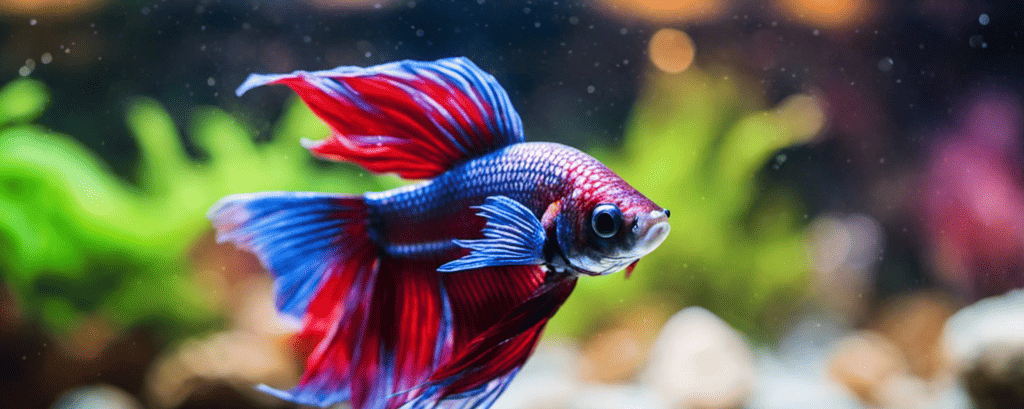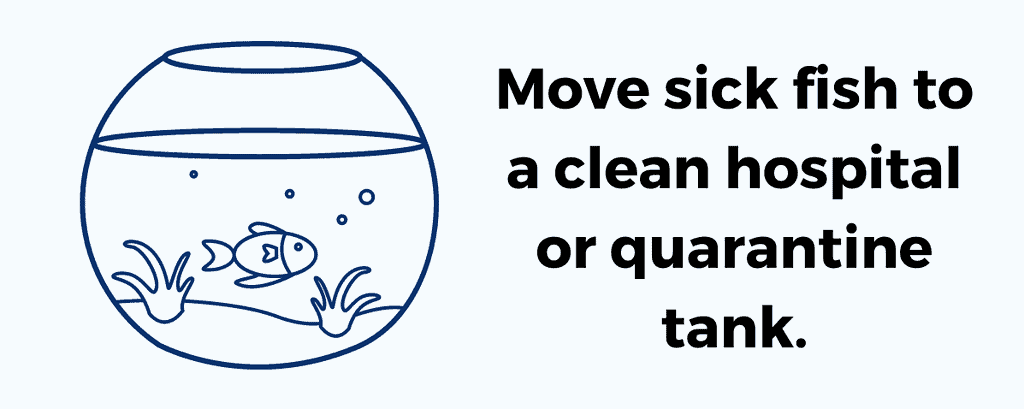Bettas are tough fish, but they still get sick.
If bettas aren’t cared for properly, the chances of fungal infections rise a ton.
Fungal infections infect your fish’s skin and eat away at it, kill organs, and may prove deadly if left untreated.
We know you don’t want this, so we wrote this guide to Betta fish fungal infections and how to help.

Table of Contents
Symptoms of Fungal Infections in Betta Fish

A fish fungus may grow all over your betta’s scales and fins.
It may look like mold or a slimy patch of white or gray and is very itchy for your pet.
Your betta may rub its body against things in the tank to relieve the itching.
Your fish may lose its appetite and appear lethargic.
They may have clamped fins or lesions on their body scales. They may also swim erratically.
How do I care for a betta fish with a fungal infection?

As with any sick fish, the first thing to do is to move your fish to a clean hospital or quarantine tank.
This gives the fish a relaxing environment and protects its tank mates.
Clean the regular tank thoroughly and change up to 30% of the water.
Make sure the water quality is good and at the proper temperature.
Bettas like to be between 78-80° degrees Fahrenheit (25.5-27° C)
Next, you will need to medicate your betta.
Select medication treating bacterial infection along with the fungus.
Some bacterial infections act like fungal infections, so it is best to treat both.
White, cottony growths are a symptom of both fungal and bacterial infection.
Follow the directions on the medication fully.
Do not stop medication because your fish looks like it is getting better. Finish the course of the medicine and do partial water changes daily.
Your betta must be in its quarantine tank for a week or two until healed.
Some fish keepers use salt baths to treat fungal outbreaks or a tea tree oil solution.
These treatments may not be strong enough to cure every infection. They have the potential to be harmful to your fish.
And, as always, make sure you are feeding your fish a high-nutrient, good-quality diet to help their immune system.
Medical Treatments For Fungal Infections

Before medicating but after moving to a quarantine tank, use this regimen to fight betta fungal infection in the tank.
Lower the temperature of your betta’s aquarium to 75-77° degrees Fahrenheit (25° C).
Remove 80% of the water in your betta’s tank, then add it back with 1 tsp aquarium salt per gallon each day for ten days.
Make sure pH levels are sufficient.
Do NOT use too much aquarium salt; it can burn your fish’s gills.
Do not use Epsom salt, marine salt, or table salt for your salt treatment.
Use the correct medication such as phenoxyethanol and follow all dosage instructions. Some cases of system fungus respond to malachite green.
Note: Speaking with a fish vet or experienced betta owner is always a good idea if you’re unsure about the treatment and using medication.
What Causes Betta Fish Fungal Infections?

Fungus is always present in aquarium water. Betta fish contract fungal infections through stress or injury.
Poor fish health makes them vulnerable
Much of the time, poor water quality leads to a fungal infection.
Fungus is usually present in the aquarium. When stressed or injured, fish become vulnerable to the fungus and get infected.
A newcomer to the tank can bring in fungal spores. They are very contagious.
Introducing a new fish is stressful and makes everyone vulnerable.
This is one reason it is advisable to quarantine new fish for a while before adding them.
Remember, equipment and aquarium decor gets contaminated. Wash and sanitize your hands, nets, siphons, cups, plants, decor, etc.
Bettas may become stressed in captivity and suffer from a variety of illnesses. Some signs your betta isn’t feeling well are color loss, loss of appetite, lethargy, and weight loss.
They may have frayed fins from nibbling at them in distress.
They may have other symptoms like:
- Cloudy eyes
- Bloating
- Labored breathing
- Watery discharge
- Erratic swimming
Stressed bettas also get fin rot, other bacterial infections, and parasites.
Preventing Fungal Infections In Your Betta

As with other fish illnesses, an ounce of prevention is worth a pound of cure. Keep your betta’s tank clean and safe.
Feed them properly and do not overhandle your pet.
Clean your fish tanks of any decaying matter, such as food or plant material. Remedy any poor living conditions.
Make regular water changes and maintain a stable pH and temperature level. Poor water quality stresses the fish and provides an opening for many common fish diseases.
Protect your betta’s mucous layer. This mucous layer prevents fungal spores from infecting them. Keep their water warm and ammonia-free.
Make sure everything in your aquarium is safe for bettas. Avoid objects with sharp edges which will cut your betta’s skin or fins.
Check all metal objects for rust and other decorations for flaking paint.
Bettas also need places to hang out and hide and swim through. Be sure to provide plenty of space for those activities.
Feed your betta a nutritious, varied diet to keep it in optimal health and able to fight off infection.
Your betta needs a mixture of tropical fish flakes, frozen live food, and betta pellets. Responsibly sourced live food is also good. Do not feed your betta food from outside.
Proper Tank Cleaning Helps Prevent fungal Infections

Before you clean your tank, take a sample and test the water quality, so you know if there are any nitrate or ammonia problems.
This will tell you how much water you need to replace with fresh, unchlorinated water.
Scrub the walls with an algae scraper and clean off the tank lid. Many fish keepers forget to clean the lid.
Use a toothbrush designated to get algae off the decor, rocks, and plants if needed.
Now is the time to prune plants by removing dead leaves and trimming foliage.
Remove 30-50% of floating plants if they have covered the water’s surface. Light needs to be able to reach the bottom of the tank.
Don’t forget to turn off the equipment in your tank. Pumps and heaters are not made to be operated out of water.
They need to be turned off, so they do not get damaged.
Vacuum the substrate using a siphon hose to remove uneaten fish food, waste, and rotting plant matter.
Fish waste and uneaten food lead to high ammonia levels. Water changes also remove the excess nitrates.
Clean the filter.
Remember, do not use soap, as it can harm your fish. Use the bucket of old tank water you’ve collected with the siphon hose.
Use the water for plant water or in the yard after you are done.
Refill your tank slowly. Use the correct amount of water conditioner and fish care products. Test the temperature carefully as drastic temperature changes will stress your fish.
Don’t forget to turn the pump and heater back on!
Keeping The Water Stable Help A Lot!
Ideal Water Parameters for a Betta Fish Tank Include the following:
- Temperature: 78-80° degrees Fahrenheit (25.5-27° C)
- pH: 6.5-7.5
- Ammonia and Nitrite: 0 ppm
- Nitrate: < 40 ppm
- gH: 3-4 dGH (50-66.7 ppm)
- kH: 3-5 dKH (53.6-89.4 ppm)
- Minimum Tank Size: 5 Gallons
Dirty aquarium water is the most common culprit in fish illnesses.
Water with too many nitrates or ammonia buildup is harmful to your fish. High chemical levels cause fish to be vulnerable to a wide range of illnesses and betta fish fungus.
High levels of chemical treatment stress your fish. This can make them vulnerable to the illnesses you are trying to prevent.
Reference this chart for our recommended water parameters:
How can I tell if my betta fish is recovering from a fungal infection?

Your betta is on the road to recovery when the fungus disappears.
Its skin heals up, and its fins heal. Their eyes will not bulge anymore.
Your fish will return to its usual vibrant color with healthy scales.
Your betta’s behavior will change.
A healthy fish will be active and swim around the tank, not just hang out at the bottom or top.
Bettas like to hide sometimes, but a healthy fish will not hide behind plants and ornaments all the time.
When your fish feels better, it will eat better. They will swim quickly to the surface at feeding time.
Your fish will breathe normally, not rapidly, and not gulping at air.
It’ll also help to check out our list of the most common betta fish illnesses.
With this, you’ll be able to tell different diseases and causes apart much better.
How Do I tell fungal infections apart from other types?

A fungal infection will be fairly obvious once it gets started.
A gray or white cottony or slimy substance will coat your fish’s skin on its head, mouth, or body. Saprolegnia2 and Ichthyophonus hoferi are two common fungal infections.
Your fish will rub against objects to relieve the irritation of the fungus.
Sometimes a bacterial infection will look like a fungal infection.
Mouth fungus in aquarium fish looks like fungus. It is actually caused by bacteria.
It is often difficult to tell what causes a fish’s illness. This leads to the practice of using a fungicide with antibacterial medication.
Fish fungi treatment strategies such as a hospital tank, water changes, and aquarium salt cover many illnesses.
Final Thoughts
Fungal infections in betta fish are very contagious and are fatal if allowed to run rampant.
Keep the water clean with weekly changes and give your fish a fungicide medication if you’re sure this is what it has.
For more on changing betta water, check out our article at the link here.


